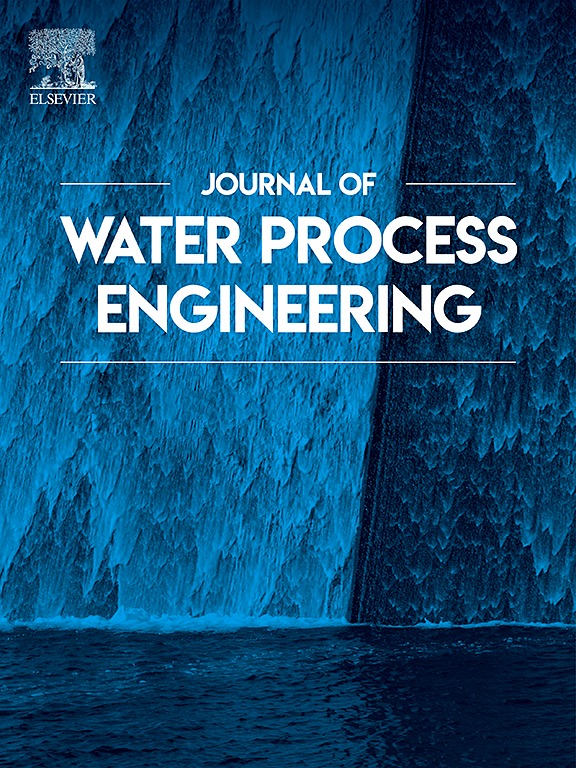Efficient treatment of graywater using a multi-array dielectric barrier discharge plasma jet
IF 6.3
2区 工程技术
Q1 ENGINEERING, CHEMICAL
引用次数: 0
Abstract
The increasing global demand for freshwater necessitates innovative and sustainable water treatment solutions. Graywater treatment and reuse have emerged as crucial strategies to alleviate pressure on freshwater resources. This study investigates the application of Dielectric Barrier Discharge (DBD) plasma for graywater treatment, a method less explored compared to conventional advanced oxidation processes (AOPs). The treatment involved exposing graywater to post-discharge plasma using air as the carrier gas. Plasma-generated reactive species were introduced into the water through bubbling, ensuring efficient mass transfer and enhancing contaminant degradation. Under optimal operating conditions (applied voltage: 7.6 kV, treatment time: 60 min, gas flow rate: 500 mL/min), the system achieved 90 % removal efficiency in a 30 mL reaction volume with an initial graywater concentration of 600 ppm. The results demonstrate the effectiveness of plasma-based ozonation for graywater treatment. Ionic analysis showed significant reductions in phosphate (from 38.05 ppm to 15.96 ppm) and sulfate (from 13.65 ppm to 6.23 ppm), both of which are critical components of graywater. Scavenger experiments revealed that singlet oxygen (1O₂), hydroxyl radicals (·OH), and ozone (O₃) were the primary reactive species responsible for degradation. This study highlights the potential of non-thermal plasma technology as a sustainable and efficient solution for graywater treatment. The findings present a promising approach to addressing global freshwater scarcity through advanced plasma-based oxidation processes.

多阵列介质阻挡放电等离子体射流高效处理灰水
全球对淡水日益增长的需求需要创新和可持续的水处理解决方案。灰水处理和再利用已成为缓解淡水资源压力的关键策略。本研究探讨了介质阻挡放电(DBD)等离子体在灰水处理中的应用,这是一种与传统的高级氧化工艺(AOPs)相比较少探索的方法。处理方法包括使用空气作为载气将灰水暴露于放电后的等离子体中。等离子体产生的反应物质通过鼓泡进入水中,确保了有效的传质,增强了污染物的降解。在最佳操作条件下(施加电压:7.6 kV,处理时间:60 min,气体流速:500 mL/min),系统在30 mL的反应体积下,初始灰水浓度为600 ppm,去除率达到90%。实验结果验证了等离子体臭氧氧化处理灰水的有效性。离子分析显示,磷酸盐(从38.05 ppm降至15.96 ppm)和硫酸盐(从13.65 ppm降至6.23 ppm)的含量显著降低,这两种物质都是灰水的关键成分。清道夫实验表明,单线态氧(O₂)、羟基自由基(·OH)和臭氧(O₃)是负责降解的主要反应物质。这项研究强调了非热等离子体技术作为一种可持续和有效的灰水处理解决方案的潜力。研究结果提出了一种有希望的方法,通过先进的等离子体氧化过程来解决全球淡水短缺问题。
本文章由计算机程序翻译,如有差异,请以英文原文为准。
求助全文
约1分钟内获得全文
求助全文
来源期刊

Journal of water process engineering
Biochemistry, Genetics and Molecular Biology-Biotechnology
CiteScore
10.70
自引率
8.60%
发文量
846
审稿时长
24 days
期刊介绍:
The Journal of Water Process Engineering aims to publish refereed, high-quality research papers with significant novelty and impact in all areas of the engineering of water and wastewater processing . Papers on advanced and novel treatment processes and technologies are particularly welcome. The Journal considers papers in areas such as nanotechnology and biotechnology applications in water, novel oxidation and separation processes, membrane processes (except those for desalination) , catalytic processes for the removal of water contaminants, sustainable processes, water reuse and recycling, water use and wastewater minimization, integrated/hybrid technology, process modeling of water treatment and novel treatment processes. Submissions on the subject of adsorbents, including standard measurements of adsorption kinetics and equilibrium will only be considered if there is a genuine case for novelty and contribution, for example highly novel, sustainable adsorbents and their use: papers on activated carbon-type materials derived from natural matter, or surfactant-modified clays and related minerals, would not fulfil this criterion. The Journal particularly welcomes contributions involving environmentally, economically and socially sustainable technology for water treatment, including those which are energy-efficient, with minimal or no chemical consumption, and capable of water recycling and reuse that minimizes the direct disposal of wastewater to the aquatic environment. Papers that describe novel ideas for solving issues related to water quality and availability are also welcome, as are those that show the transfer of techniques from other disciplines. The Journal will consider papers dealing with processes for various water matrices including drinking water (except desalination), domestic, urban and industrial wastewaters, in addition to their residues. It is expected that the journal will be of particular relevance to chemical and process engineers working in the field. The Journal welcomes Full Text papers, Short Communications, State-of-the-Art Reviews and Letters to Editors and Case Studies
 求助内容:
求助内容: 应助结果提醒方式:
应助结果提醒方式:


